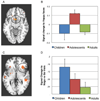Adolescence: what do transmission, transition, and translation have to do with it?
- PMID: 20826307
- PMCID: PMC3014527
- DOI: 10.1016/j.neuron.2010.08.033
Adolescence: what do transmission, transition, and translation have to do with it?
Abstract
Negotiating the transition from dependence on parents to relative independence is not a unique demand for today's youth but has a long evolutionary history (transmission) and is shared across mammalian species (translation). However, behavioral changes observed during this period are often described as delinquent. This review examines changes in explorative and emotive behaviors during the transition into and out of adolescence and the underlying neurobiological bases in the context of adaptive and maladaptive functions.
2010 Elsevier Inc. All rights reserved.
Figures




References
-
- Aksglaede L, Sorensen K, Petersen JH, Skakkebaek NE, Juul A. Recent decline in age at breast development: the Copenhagen Puberty Study. Pediatrics. 2009;123:e932–e939. - PubMed
-
- Andersen SL, Thompson AT, Rutstein M, Hostetter JC, Teicher MH. Dopamine receptor pruning in prefrontal cortex during the periadolescent period in rats. Synapse. 2000;37:167–169. - PubMed
-
- Argente J. Diagnosis of late puberty. Horm Res. 1999;51 Suppl 3:95–100. - PubMed
-
- Astle DE, Scerif G. Using developmental cognitive neuroscience to study behavioral and attentional control. Dev Psychobiol. 2009;51:107–118. - PubMed
Publication types
MeSH terms
Grants and funding
LinkOut - more resources
Full Text Sources
Medical

